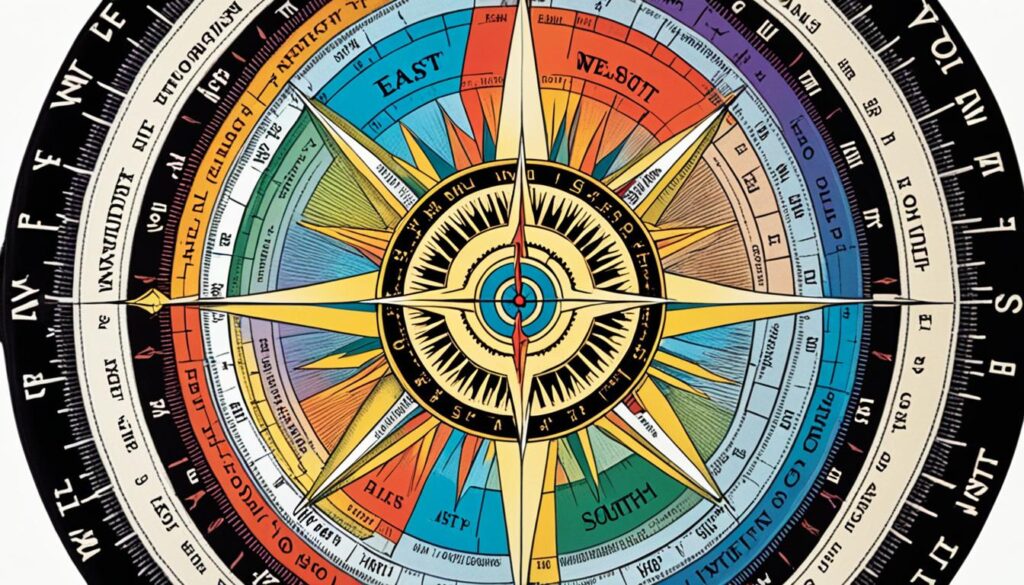Are you aware that the four cardinal directions: North, South, East, and West, have an impact on your personality? Indeed, they do! Each cardinal point symbolizes a distinct collection of characteristics and inclinations that contribute to your personal identity. Recognizing which direction corresponds with your primary personality traits can offer essential understanding into your capabilities, areas for improvement, and ways of interacting.
Key Takeaways:
- The East West North South Personality Test helps you discover your dominant personality traits based on the four primary directions: North, South, East, and West.
- Understanding your primary direction can provide valuable insights into your strengths, weaknesses, and preferred communication style.
- The four personality types in the test are North (assertive and goal-centered), South (team-oriented and helpful), East (organized and analytical), and West (flexible and creative).
- Recognizing and appreciating the differences among the types can foster effective communication and collaboration.
- Applying the insights from the personality test can enhance personal and professional development, improve teamwork, and develop effective leadership skills.
Understanding the Personality Compass
The Personality Compass is a powerful psychological tool that helps individuals gain a deeper understanding of themselves and others. By categorizing individuals into four main personality types based on their preferences and traits, the Personality Compass provides valuable insights into individual behavior and interactions.
The four main personality types in the Personality Compass are North, South, East, and West. Each type has its own unique characteristics, strengths, and perspectives. Understanding these types can help us navigate and better comprehend the diverse range of personalities we encounter in our personal and professional lives.
“The Personality Compass is like a geographical map that guides us through the vast and intricate landscape of human behavior. It helps us uncover the hidden treasures within ourselves and discover the beauty in our differences.”
Personality assessment is a fundamental component of the Personality Compass. By evaluating individuals’ preferences, traits, and tendencies, it provides a comprehensive profile that sheds light on their natural inclinations. This profile acts as a compass, showing the way to self-awareness and personal growth.
Geographical Personality Test
The Personality Compass draws inspiration from the concept of a geographical personality test. Just as different regions on Earth possess distinct traits and characteristics, so do different personality types. Through this geographical analogy, the Compass helps us visualize and understand the complexities of human behavior.
| Personality Type | Characteristics | Strengths |
|---|---|---|
| North | Ambitious, assertive, goal-oriented | Decisiveness, leadership skills, determination |
| South | Warm, empathetic, team-oriented | Collaboration, communication, supportiveness |
| East | Analytical, organized, detail-oriented | Problem-solving, critical thinking, efficiency |
| West | Creative, innovative, flexible | Adaptability, out-of-the-box thinking, intuition |
The table above provides a brief overview of the characteristics and strengths associated with each personality type. However, it is essential to remember that these descriptions represent broad generalizations and that every individual is unique. We all have a mix of traits from each direction, but the Compass helps us identify our dominant personality type and how it influences our approach to life.
The Personality Compass serves as a valuable tool for personal and professional development, as well as for enhancing interpersonal relationships. By understanding our own personality type and appreciating the diversity of others, we can foster effective communication, collaboration, and empathy.
How to Determine Your Primary Direction
To determine your primary direction on the Personality Compass, you have two options: you can take an online test or use a simple method of self-reflection. Let’s explore both approaches:
Option 1: Personality Compass Online Test
One convenient way to determine your primary direction is by taking an online test specifically designed for the Personality Compass. These tests are easily accessible and can provide you with valuable insights into your dominant personality traits. They typically involve a series of questions that assess your preferences and behaviors, leading to an accurate identification of your primary direction. Best of all, many of these tests are available for free, making them accessible to everyone.
To find a reliable personality compass online test, simply search the web using relevant keywords like “personality compass online test” or “east west north south personality test free.” Be sure to choose a reputable test from a reliable source for accurate results. Once you complete the test, you will receive a detailed assessment of your primary direction and a breakdown of your dominant traits.
Option 2: Self-Reflection
If you prefer a more introspective approach, you can determine your primary direction through self-reflection. Start by considering the characteristics that are least like you. Think about traits that you don’t enjoy, tend to avoid, or make you feel uncomfortable. By identifying the direction that represents these least like characteristics, you can then look at the opposite direction to determine your primary direction.
For example, if you find that you are least like the North direction, which is assertive and goal-centered, your primary direction may be the South, East, or West. By considering the characteristics of these three remaining directions, you can narrow down your primary direction based on which one resonates with you the most.
Whichever method you choose, it’s important to remember that the primary direction revealed by the personality compass is just one aspect of your personality. We all have traits from each direction, but one stands out as the dominant force shaping our behavior and preferences.

| Option | Advantages | Disadvantages |
|---|---|---|
| Personality Compass Online Test | – Convenient and accessible – Provides accurate results based on structured assessment – Many free tests available |
– Relies on subjective self-reporting – May not capture the complexity of individual personalities entirely |
| Self-Reflection | – Introspective and self-paced – Allows for personal insights and exploration – Provides a deeper understanding of one’s personality |
– Relies on personal interpretation – Can be influenced by biases or limited self-awareness |
The Four Personality Types
When it comes to the Personality Compass, there are four distinct personality types: North, South, East, and West. Each type has its own unique set of characteristics and traits that define their approach to life and interactions with others.
Let’s take a closer look at each personality type:
North Personality Type
The North personality type is characterized by assertiveness, goal-centeredness, and a competitive nature. Individuals with a dominant North direction are often driven by ambition and motivated to achieve success. They are confident decision-makers who thrive in leadership roles.
South Personality Type
The South personality type is known for being team-oriented, patient, and helpful. People with a dominant South direction prioritize collaboration and interpersonal relationships. They excel in roles that require empathy, support, and a strong sense of teamwork.
East Personality Type
The East personality type is organized, analytical, and detail-oriented. Those with a dominant East direction have a natural inclination towards structure, planning, and precision. They excel in roles that require logical thinking, problem-solving, and attention to detail.
West Personality Type
The West personality type is characterized by flexibility, innovation, and creativity. Individuals with a dominant West direction possess a natural curiosity and an ability to think outside the box. They excel in roles that require imagination, adaptability, and a fresh perspective.
| Personality Type | Characteristics |
|---|---|
| North | Assertive, goal-centered, competitive |
| South | Team-oriented, patient, helpful |
| East | Organized, analytical, detail-oriented |
| West | Flexible, innovative, creative |
Understanding the four personality types in the Personality Compass can provide valuable insights into individual behavior, preferences, and strengths. Each type brings a unique perspective to interpersonal relationships and the workplace, contributing to a diverse and dynamic society.

Careers and the Four Personality Directions
Understanding your primary direction on the Personality Compass can provide valuable insights into career choices and job positions that align with your dominant personality traits. Each of the four compass points – North, South, East, and West – has its own unique characteristics and strengths that lend themselves well to different career paths.
Take a look at the table below to see how the different compass points correspond to various career types:
| Compass Point | Career Types |
|---|---|
| North | Leadership roles, goal-oriented positions, decision-making positions |
| South | Collaborative roles, support-oriented positions, customer service |
| East | Analytical roles, organized positions, research, data analysis |
| West | Creative roles, innovative positions, artistic pursuits |
Remember, while these career types are often associated with each compass point, it’s important to note that individuals can excel in various fields regardless of their primary direction. The Personality Compass is meant to provide a guide, but it’s not a definitive measure of success in a particular career.
Keep in mind that your dominant personality direction doesn’t mean you can’t explore other career paths or develop skills related to other compass points. It simply indicates the direction that aligns most strongly with your natural inclinations and strengths.
Key Takeaways:
The Personality Compass can provide insights into careers that align with your dominant personality direction.
North types may excel in leadership and goal-oriented positions, while South types thrive in collaborative and support-oriented roles. East types may excel in analytical and organized positions, while West types may thrive in creative and innovative fields.
Remember, these associations are not set in stone, and individuals can find success in various fields regardless of their primary direction.

Exploring careers that resonate with your dominant direction on the Personality Compass can help you find fulfillment and success in your professional life. Remember to also consider your interests, values, and personal goals when making career decisions.
Next, we’ll delve into the differences and similarities among the four personality types to gain a deeper understanding of the unique traits and perspectives within the Personality Compass.
Differences and Similarities Among the Types
While each personality type has its own unique characteristics, strengths, and weaknesses, there are also commonalities among the different types. Understanding these differences and similarities is essential for fostering effective communication and collaboration.
Differences Among the Types
Let’s explore some of the key personality differences:
- North types are typically assertive, goal-centered, and competitive, focusing on achieving results.
- South types lean towards being team-oriented, patient, and helpful, valuing collaboration and support.
Conversely, East types lean towards being organized, analytical, and detail-oriented, with a methodical approach to tasks and problems.
Meanwhile, West types are often described as flexible, innovative, and creative, bringing fresh perspectives to various situations.
Similarities Among the Types
Although there are distinct differences, it’s important to note some commonalities shared by the personality types:
- North and East types tend to be more results-oriented and focused on achieving goals.
- South and West types, on the other hand, may be more relationship-oriented and value-driven.
Recognizing and appreciating these differences and similarities can help create a more harmonious and collaborative environment, promoting effective teamwork and communication.
| Personality Type | Characteristics |
|---|---|
| North | Assertive, goal-centered, competitive |
| South | Team-oriented, patient, helpful |
| East | Organized, analytical, detail-oriented |
| West | Flexible, innovative, creative |

Dominant and Subdominant Personality Types
In the Personality Compass, our individual personalities are shaped by a dominant type, our primary direction, and a subdominant type, our second strongest direction. Both of these types work together to create a more comprehensive understanding of who we are. While our dominant type represents our primary traits, our subdominant type adds depth and nuance to our personality.
Let’s take a closer look at how these dominant and subdominant types interact and influence our overall personality. The dominance of each type can vary from person to person, resulting in different combinations of dominant and subdominant types.
| Personality Type | Dominant Traits | Subdominant Traits |
|---|---|---|
| North | Assertive, goal-centered, competitive | Decisive, independent, driven |
| South | Team-oriented, patient, helpful | Supportive, empathetic, nurturing |
| East | Organized, analytical, detail-oriented | Logical, methodical, systematic |
| West | Flexible, innovative, creative | Adaptive, intuitive, imaginative |
It’s important to remember that these dominant and subdominant types are not static labels, but rather flexible frameworks that provide insights into our preferences and strengths. They offer valuable guidance for self-awareness and personal growth.

*The compass point chart visually represents the dominant and subdominant personality types in the Personality Compass.
The Optimal Discussion for Each Compass Point
The optimal discussion for each compass point depends on the characteristics and preferences of that particular type. Understanding and adapting to these differences can significantly enhance group dynamics and promote effective communication and collaboration.
North Types:
North types are assertive, goal-oriented individuals who thrive in direct and efficient discussions. They appreciate concise communication, focused on achieving results and making progress. Their preference is for discussions that are structured, action-oriented, and have clear objectives. It is important to stay on track and avoid unnecessary digressions to keep North types engaged.
East Types:
East types are organized and analytical individuals who enjoy in-depth analysis and structure. They value discussions that allow for detailed exploration of ideas and concepts. East types thrive when discussions are logical, systematic, and provide a comprehensive understanding of the topic at hand. They prefer conversations that are well-organized and follow a clear outline or agenda.
South Types:
South types are team-oriented and patient individuals who appreciate discussions that foster collaboration and consensus-building. They value open dialogue, where everyone’s opinions and ideas are heard and respected. South types feel most comfortable in discussions that allow for equal participation and involvement from all participants. They excel in creating a supportive and inclusive atmosphere.
West Types:
West types are flexible and creative individuals who thrive in discussions that encourage innovation and outside-the-box thinking. They appreciate brainstorming sessions that allow for the exploration of new ideas and possibilities. West types excel in discussions that foster a free flow of ideas, creativity, and imagination. They contribute by offering unique perspectives and unconventional solutions.
By adapting the discussion style to accommodate the preferences of each compass point, group dynamics can be optimized. This allows for a more inclusive and productive discussion, leveraging the diverse personality traits of each individual. Effective communication within the group is essential for achieving common goals and maintaining a harmonious working environment.
The Importance of Understanding Differences
Effective communication and collaboration in a team or group setting rely heavily on understanding the differences among the four compass points. Each type brings unique strengths and perspectives, creating a diverse and valuable collective. By appreciating and valuing these differences, we can leverage the individual strengths of each compass point to achieve our common goals.
“Strength lies in differences, not in similarities.” – Stephen R. Covey
When we embrace and respect personality differences, we unlock the full potential of effective collaboration. Each compass point offers a distinct set of skills and insights that contribute to the overall success of a team. By valuing diversity, we create a harmonious environment where every individual feels empowered to express their ideas and contribute meaningfully to the group’s efforts.
Fostering Effective Collaboration
To foster effective collaboration, it is essential to recognize and appreciate the unique characteristics that each compass point brings to the table.
- The North type brings assertiveness and goal-oriented focus, driving the team forward with determination and clarity.
- The South type embodies teamwork, patience, and a helping spirit, creating a supportive and harmonious atmosphere within the group.
- The East type adds organization, analytical thinking, and attention to detail, ensuring that projects are well-structured and executed with precision.
- The West type introduces flexibility, innovation, and creativity, inspiring fresh ideas and imaginative problem-solving approaches.
By acknowledging and embracing these diverse perspectives, we open ourselves up to a world of possibilities and enhanced collaboration. The varied strengths and viewpoints of each compass point complement one another, leading to more informed decision-making, creative problem-solving, and successful outcomes.

The Role of Perception in Relationships
Perception plays a significant role in how individuals interpret and understand each other in relationships. Our unique personalities, influenced by our dominant and subdominant compass points, shape our perceptions and point of view.
When we interact with others, we bring our own perspective to the table, which may differ from theirs. This divergence in perception can either enhance or hinder our relationships. It is important to acknowledge that multiple perceptions can coexist and that understanding and respecting different points of view can lead to stronger and more harmonious connections.
“The greatest glory in living lies not in never falling, but in rising every time we fall.” – Nelson Mandela
By recognizing the role of perception, we become more attuned to the dynamics of our relationships. We understand that our own viewpoint is not the only valid one, and we become open to considering others’ perspectives.
Fostering Understanding and Empathy
Developing empathy and understanding is crucial in navigating the complexities of relationships. By actively seeking to understand where others are coming from, we can bridge the gap created by differing perceptions.
When conflicts arise, it is important to approach them with an open mind and a willingness to listen. By genuinely trying to understand the other person’s perspective, we can find common ground and resolutions that honor both parties’ needs.
The Power of Communication
Clear and effective communication is key to overcoming perceptual differences in relationships. When expressing our thoughts and feelings, it is essential to use language that is inclusive and respectful.
Active listening is equally important. By giving our full attention and seeking to understand rather than just respond, we create an environment where different perceptions can be heard and appreciated.
| Benefits of understanding perception in relationships: |
|---|
| Enhanced empathy |
| Improved conflict resolution |
| Stronger relationships |
| Effective communication |
When we actively work on understanding perception in relationships, we can build stronger connections and navigate challenges more effectively. By embracing diverse perspectives and valuing different points of view, we foster a culture of empathy, respect, and harmony.

Similarities Among the Types
While each compass point has its own unique characteristics, there are also similarities among the types. Understanding these shared traits can foster a sense of common ground and facilitate effective collaboration.
For instance, North and East types both value efficiency and goal-oriented behavior. They thrive in structured environments and enjoy working towards measurable objectives. Whether it’s meeting deadlines or accomplishing tasks, their drive for results is a shared characteristic.
On the other hand, South and West types both prioritize relationships and a people-centered approach. They excel in team-oriented settings and value collaboration and support. Building strong connections and fostering a positive work environment are key common traits for these types.
Recognizing these similarities can help us find areas of alignment and better understand one another. By acknowledging the common ground, we can bridge differences and enhance our collaborative efforts.
The Impact of Compass Points in Group Dynamics
Group dynamics and collaborative work are greatly influenced by the compass points in the Personality Compass. Each type brings specific strengths and perspectives to the group, shaping decision-making processes and interpersonal relationships. By understanding and appreciating these dynamics, groups can leverage the diverse strengths of each compass point to achieve collective success.
“The collaboration of different compass points leads to a synergy of ideas and approaches that can propel a group towards innovation and balanced decision-making.”
When individuals with different compass points come together, they bring unique perspectives and skill sets that enhance the group’s overall performance. North types, with their assertiveness and goal-oriented nature, may provide direction and drive. South types, on the other hand, with their team-oriented mindset and patience, can foster collaboration and build strong relationships within the group.
East types, known for their organizational skills and attention to detail, contribute structure and methodical thinking. Meanwhile, West types bring flexibility, innovation, and creativity, injecting fresh ideas and alternative perspectives into team discussions.
Understanding and leveraging these diverse strengths can lead to stronger problem-solving capabilities and more effective group dynamics. By embracing the compass points and fostering an inclusive environment that values each individual’s contributions, groups can tap into the collective intelligence and achieve optimal outcomes. This can be achieved through open and respectful compass point discussions that allow for the exploration of different perspectives and ideas.
Cultivating a Collaborative Environment
In order to create a collaborative environment where all compass points can thrive, it is essential to establish clear communication channels and foster an atmosphere of inclusivity. Encouraging active participation from all group members and valuing diverse opinions can help prevent dominant personalities from overshadowing valuable contributions from other compass points.
- Developing active listening skills
- Encouraging open and respectful communication
- Creating opportunities for equal participation
- Fostering a culture of constructive feedback
- Recognizing and appreciating the strengths of each compass point
By embracing the concept of the Personality Compass in group dynamics, individuals can enhance their understanding of one another and capitalize on the unique strengths each compass point brings. The collaborative interplay of these different perspectives can result in innovative ideas, effective problem-solving, and successful team outcomes.

Applying Compass Points in Personal and Professional Development
The insights gained from understanding the compass points can have a profound impact on personal and professional development. By recognizing and leveraging our dominant and subdominant types, we can enhance our self-awareness, improve our communication skills, and develop effective leadership styles. Embracing our unique attributes can lead to personal growth and success in various aspects of our lives.
Enhancing Self-Awareness
Understanding our dominant and subdominant types provides valuable insight into our personality traits, preferences, and strengths. It allows us to identify areas of personal development and focus on building upon our natural abilities. By leveraging self-awareness, we can make informed decisions, better manage our emotions, and cultivate healthy relationships both personally and professionally.
Improving Communication Skills
Effective communication is essential for building positive relationships and achieving successful outcomes. By understanding the compass points, we gain insight into the communication styles of others and can adapt our approach accordingly. For example, if we know someone has a dominant North type, we can engage in direct and goal-oriented discussions, while with someone with a dominant West type, we may explore innovative and creative ideas. This knowledge enables us to connect with others more effectively, minimize misunderstandings, and foster collaboration.
Developing Effective Leadership Styles
Leadership skills are vital for success in both personal and professional settings. By understanding our dominant and subdominant types, we can tailor our leadership approach to leverage our natural strengths. For instance, a leader with a dominant South type may excel in team-oriented environments, where they can foster collaboration and support the development of their team members. On the other hand, a leader with a dominant East type may thrive in structured and analytical settings, showcasing their organizational skills and attention to detail. By adapting our leadership style to match our compass type, we can inspire and motivate others, driving positive change and achieving our goals.
| Application | Benefits |
|---|---|
| Self-awareness | Improved decision-making, emotional intelligence, and relationship management. |
| Communication Skills | Enhanced understanding, effective collaboration, and minimized conflicts. |
| Leadership Styles | Optimized utilization of strengths, increased team performance, and goal achievement. |
Using the Compass Points for Team Building and Leadership Development
Team building and leadership development are critical components of fostering a collaborative and successful work environment. By leveraging the insights gained from the compass points, leaders can create teams that embrace diversity and harness the unique strengths of each individual. This holistic approach enhances teamwork, decision-making, and overall organizational performance.
Understanding the different compass types within a team is key to building an inclusive and balanced environment. Each personality type brings distinct perspectives, skills, and contributions to the table. By recognizing and valuing these differences, leaders can establish a culture of collaboration and growth.
Incorporating compass point discussions and activities into team building exercises can be highly effective. These interactive sessions encourage team members to identify and appreciate the diverse perspectives and skills within their group. By engaging in open dialogue and exercises that promote self-awareness, individuals can develop a deeper understanding of themselves and their peers.
Moreover, the compass points provide a framework for exploring team dynamics and addressing areas of improvement. Leaders can identify potential gaps in skill sets or communication styles and develop targeted strategies to enhance collaboration. By aligning individuals’ strengths and preferences with specific roles and tasks, leaders can ensure that teams are not only productive but also aligned with organizational goals.
Fostering Collaboration
Collaboration is a cornerstone of effective team building and leadership development. The compass points offer valuable insights into how individuals collaborate and contribute to team efforts. By aligning team members according to their personality types, leaders can create synergies and capitalize on diverse perspectives.
“The strength of the team is each individual member. The strength of each member is the team.”– Phil Jackson
Recognizing and appreciating the unique strengths of each compass point can lead to improved communication and collaboration. For example, North types may excel in setting clear goals and driving results, while South types may thrive in supporting others and building relationships. East types can bring analytical thinking and organization to the table, while West types can inspire innovation and creativity.
Leadership Development
Leadership development is an essential aspect of team building. The compass points provide valuable insights into leadership styles and preferences. Understanding these nuances can help leaders adapt their approaches to better suit the individuals they lead.
Leaders can use the compass points as a reference to identify their own leadership strengths and areas for growth. By recognizing their dominant and subdominant types, leaders can leverage these characteristics to enhance their leadership style and address potential blind spots.
Furthermore, the compass points can inform leadership development programs, helping leaders tailor their strategies to foster growth and empower their teams. By embracing the unique strengths of each personality type, leaders can create a supportive and inclusive environment that encourages the development of individual potential.
| Compass Point | Leadership Style |
|---|---|
| North | Decisive, goal-oriented, and results-driven |
| South | Supportive, empathetic, and relationship-oriented |
| East | Structured, analytical, and detail-oriented |
| West | Innovative, adaptable, and creative |

In conclusion, the compass points provide valuable insights for team building and leadership development. By leveraging the strengths and diversity of each personality type, leaders can create cohesive and high-performing teams. Incorporating compass point discussions and activities can foster collaboration, improve communication, and enhance leadership effectiveness. Ultimately, by embracing the power of the compass points, organizations can unlock the full potential of their teams and drive sustainable success.
Conclusion
The East West North South Personality Test is a valuable tool for gaining insights into our individual personality traits and preferences. By understanding the unique characteristics associated with each compass point, we can gain a deeper understanding of ourselves and others, leading to improved communication, collaboration, and personal growth.
Embracing the diversity of the compass points allows us to appreciate the varied strengths and perspectives that each type brings to the table. This appreciation fosters positive relationships and creates a more inclusive environment, both personally and professionally. By utilizing the insights gained from this psychological compass, we can enhance our self-awareness, develop effective communication strategies, and cultivate strong leadership skills.
As an individual, the East West North South Personality Test helps us navigate our own personality traits and understand how they influence our interactions with others. By unlocking this self-awareness, we can enhance our personal growth and make conscious choices that align with our authentic selves. Whether we identify with the assertive North type, the team-oriented South type, the organized East type, or the flexible West type, the compass points offer us a compass for self-reflection and self-improvement.
Can the East West North South Personality Test Determine Guardian/Protector Personality Types?
The East West North South Personality Test is not designed to specifically determine guardian protector personality types. This test categorizes individuals based on their responses to various situational scenarios. However, the results may indirectly reveal traits commonly associated with the guardian protector personality type.
FAQ
What is the East West North South Personality Test?
The East West North South Personality Test is designed to help individuals discover their unique personality traits based on the concept that everyone has characteristics from each of the four directions – North, South, East, and West – but one direction will capture the essence of their personality more accurately than the others.
How can I determine my primary direction on the Personality Compass?
You can take an online test or use a simple method of self-reflection to determine your primary direction. One approach is to identify the direction that is least like you, and then look at the opposite direction to determine your primary direction.
What are the four personality types in the Personality Compass?
The four personality types in the Personality Compass are North, South, East, and West. Each type has its own unique characteristics and traits.
How do the personality types align with careers and job positions?
Each primary direction in the Personality Compass aligns well with certain careers and job positions. For example, those with a dominant North direction may excel in leadership roles, while those with a dominant South direction may thrive in collaborative and support-oriented roles.
What are the differences and similarities among the four compass points?
Each compass point has its own unique characteristics, strengths, and weaknesses, but there are also commonalities among the different types. For example, North and East types tend to be more results-oriented, while South and West types may be more relationship-oriented.
What is the impact of the compass points on group dynamics and collaboration?
The compass points have a significant impact on group dynamics and collaboration. Each type brings specific strengths and perspectives, which can influence decision-making processes and interpersonal relationships.
How can the insights from the compass points be applied to personal and professional development?
Understanding the compass points can be applied to personal and professional development by leveraging dominant and subdominant types to enhance self-awareness, improve communication skills, and develop effective leadership styles.
How can the compass points be used for team building and leadership development?
By understanding the different compass types within a team, leaders can create a more inclusive and balanced environment that leverages the strengths of each individual. Compass point discussions and activities can help teams identify and appreciate diverse perspectives and skills.
What are the benefits of understanding the compass points?
Understanding the compass points offers valuable insights into individual personality traits, which can lead to improved communication, collaboration, personal growth, and success in both personal and professional settings.
Augustus is the visionary leader and Editor-in-Chief of Personality-Test.net. With an unwavering commitment to quality and authenticity, he oversees all content, ensuring it enlightens and empowers our audience. Augustus believes deeply in the transformative power of self-awareness and is dedicated to making Personality-Test.net a beacon for those on a journey to understand themselves better.










